Good Indian Monsoon Tipped to Keep Rupee Supported
- Monsoon season begins with a 'good' year forecast
- This could reduce food price inflation
- But, inflation may still rise due to inflating core elements, lending support to the Rupee

© Hemant, Adobe Stock
The rainy season in India is an important factor impacting on the economy as only half of the country's crops benefit from irrigation leaving the other half at the mercy of direct rainfall.
The monsoon, which happens between June and September, also impacts on Indian politics, with "rainfall performance perceived as an important factor in determining the incumbent political party’s electoral prospects," according to Kanika Pasricha, India economist for Standard Chartered.
The monsoon can be a volatile economic variable since the amount and extent of the rains can vary considerably from year to year.
A lack of rain leads to poor crops which in turn leads to higher headline inflation since 46% of headline CPI is composed of food.
But at the same time, a good monsoon should add to Indian economic growth and increase spending power, which should in turn feedback into rising core prices. And if we consider that the Reserve Bank of India will be more inclined to raise interest rates in response to the latter type of inflation (core inflation), then the forecasts for a good monsoon are likely to play positive for the Indian currency.
Higher core inflation can have a knock-on effect on the country's currency if it leads to the central bank raising interest rates in order to put a lid on rising prices. Higher interest rates in turn attracts greater foreign capital inflows, which strengthens demand for the currency and lead to its appreciation.
Well Distributed Monsoon
In 2018, the good news for Indian farmers is that the monsoon is forecast to be 'good' by which it is meant better "geographically distributed" than usual, according to the Indian Meteorological Department (IMD).
In particular, the bread-basket zone in the northwestern region of India, which is the most significant agricultural area of the country, contributing 45% of total crops, is forecast to have good rains after a 4-year gap.
The IMD also forecasts July and August which are the two most important months for farmers to have better-than-usual rainfall.
April saw a surprise increase in Indian inflation when it rose from 4.28% to 4.58%.
This sudden lift in inflation had analysts changing their neutral outlook for interest rates in India, and led to increased expectations that the Reserve Bank of India (RBI) would hike rates at some point in the summer (probably August), with DBS Bank's Radikha Rao even seeing an outside risk of a rise at the June 6 meeting.
Another inflationary factor to watch is the government's agricultural subsidy, called the MSP (Minimum Support Prices) which fixes wholesale prices for foodstuffs is expected to rise significantly so as to provide a 50% profit margin, alleviating rural hardship.
"Impending MSP hikes, which the government has said will provide a 50% premium over production costs, are likely to pose upside risk of 35-40bps to our FY19 CPI inflation forecast of 4.8%," says Pasricha.
But, t is worth considering that the IMD monsoon forecast comes with some important provisos, according to Standard Chartered's Pasricha.
The first is that the IMD is not always right: "although the IMD’s forecast was correct last year, rains have deviated from its forecasts in the past," says the economist.
Second, the progress of rains in the less well irrigated southern and eastern regions is likely to have a disproportionate impact and needs to be monitored carefully.
Taking into account the recent rise in oil prices, the expected increase in MSPs and the trend higher in core prices, inflation may still move higher regardless of the outcome of the monsoons, and the RBI is still likely to be highlighted for a potential hike, if not tomorrow now then perhaps later in the year.
And this should ultimately be supportive of the INR.
Advertisement
Get up to 5% more foreign exchange by using a specialist provider to get closer to the real market rate and avoid the gaping spreads charged by your bank when providing currency. Learn more here



